You may not find this terribly rewarding unless you're included here, so this is a good time for casual and random browsers to turn back before they get too caught up in the sweep and majesty of the proceedings and can't let go.
It's about an hour's drive from Gubbio southwestward through the mountains to Perugia, now a small hilltop city of some 70,000 near the upper Tiber river, but one with a medieval centre that stands out even in a region full of medieval hilltop cities.
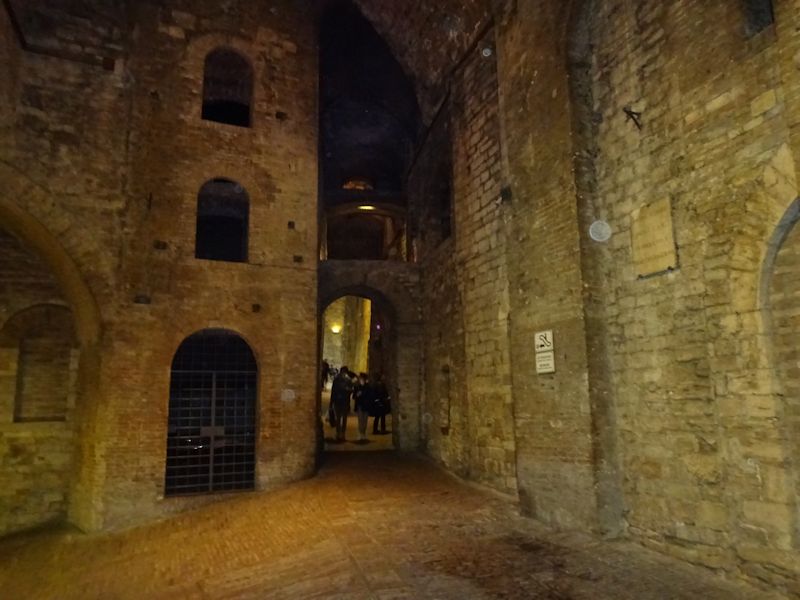
There was an Albornoz fortress in Perugia, built on the hill just north of the cathedral by the infamous papal legate in 1373 during his campaign to reclaim the cities of the region for Pope Innocent VI -- it was said to have been the largest of its time. As in other cities, however, there was a rapid reaction to the papal overreaching from Avignon, and in this case the Rocca del Sole was destroyed three years later by the citizens of the town.
In 1540, however, the popes were back, the Farnese Pope Paul III specifically at the successful conclusion to his crushing of Perugia's 'Salt War' rebellion, and a whole neighborhood on the town's other hill, south of the cathedral, was knocked down to create this Rocca Paolina. The fortress was demolished in the 19th century, but its foundations and some other parts remain, and here we are. This is the way from the convenient carpark at the Piazza Partigiani outside the walls, up escalators through what's left of the fortress and some of the Etruscan remains within which it was built.

The underground tour of the Rocca Paolina pops out at the Piazza Italia next to the Palazzo del Governo (on the left) and other huge 19th century buildings at the southern end of the centro storico.
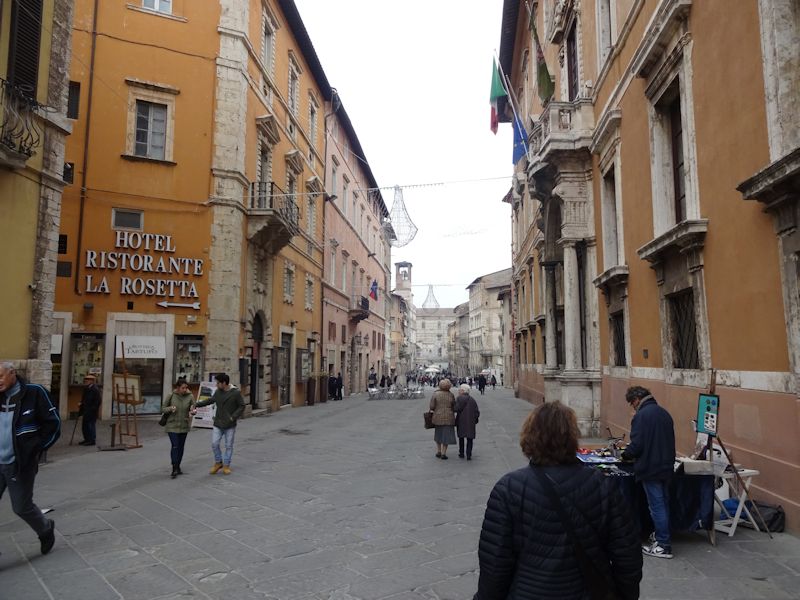
The high street, the Corso Pietro Vannucci (aka the Renaissance painter called il Perugino), from the Piazza Italia looking northward towards the Duomo
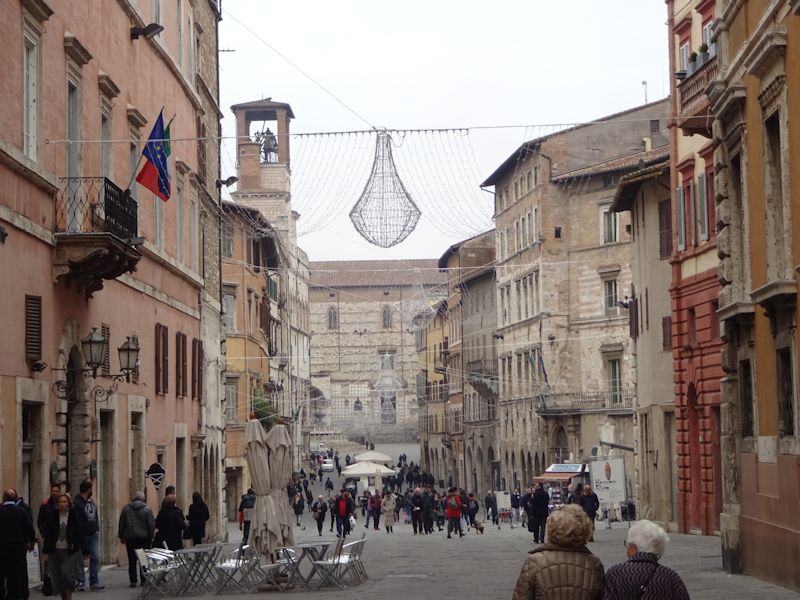
The length of the Corso Vannucci, zoomed. Perugia evidently began as an Umbrian settlement, but because of its central and strategic location along the Tiber, it was from an early date counted amongst the twelve important cities of the Etruscan League. It was defeated by the Romans in 308 BC and brought under Roman control at the end of the 3rd Samnite War in the 290s BC.
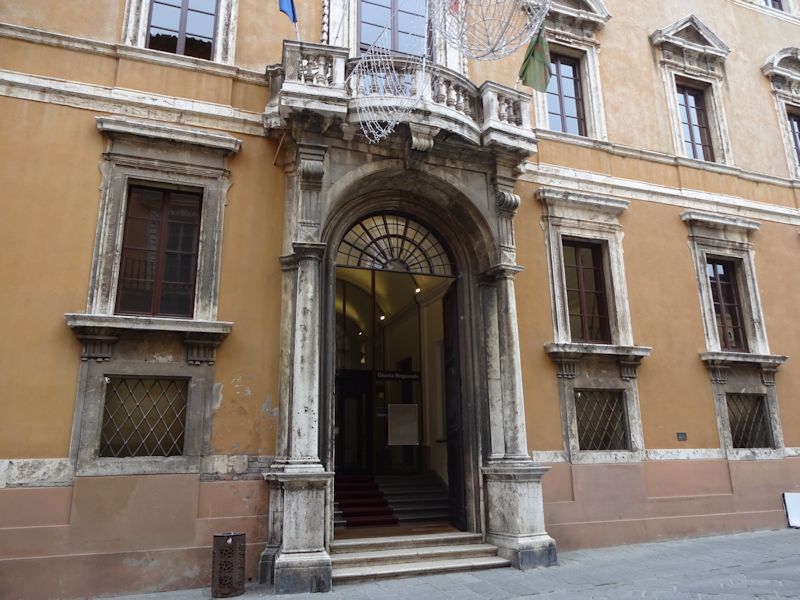
In the "Perusine War", Marc Antony's wife Fulvia and his brother rebelled in 41 BC against the rule of Octavian and the Second Triumvirate but had to fall back into Perugia, where they were besieged by Octavian's legions. The city was forced to surrender some months later due to starvation; the principals were spared, but the townspeople were killed or evicted to make way for the settlement of retired legionaries. It was resettled again, with the status of a colonia, in the AD 250s.

An elderly gentleman wandering along by himself, shouting about how the blacks are taking over the country and should be shipped back to Africa where they belong, and being given a very wide berth by pedestrians

In the Piazza Bonazzi. During the Gothic Wars, the Ostrogoth Totila attacked the city, and its bishop St Herculanus (Sant'Ercolano) came out to try tricking the king into sparing the city; no dice, and Totila is said to have captured the city and to have had the bishop flayed and beheaded (40 days later, however, his head was found to be back on him). He's presently one of the several patron saints of Perugia.
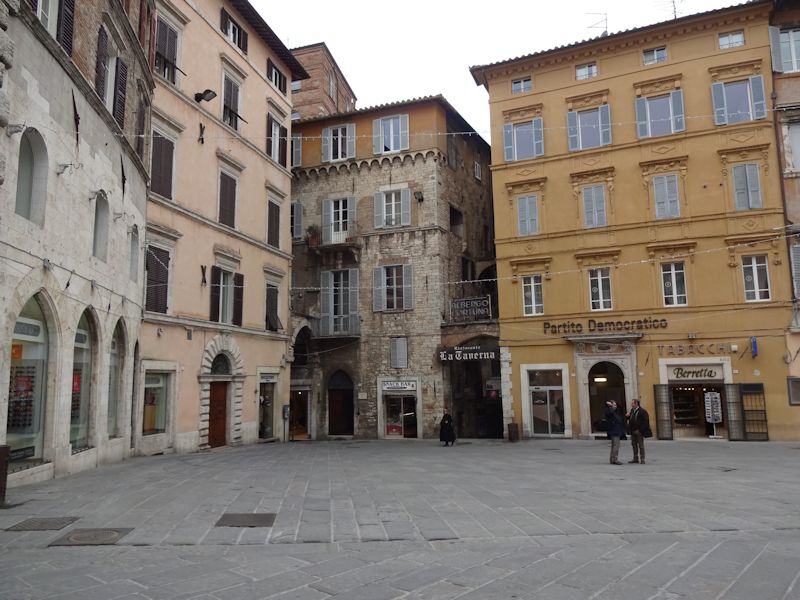
The Piazza Bonazzi along Corso Vannucci

Perugia was incorporated into the Lombard Duchy of Spoleto by about 600 and later learnt to govern itself as a vassal of the papacy, until by the mid-12th century it was recognized as an independent commune. There was a papal residence here, and throughout the 13th century, when Rome was unsafe, five popes were elected here in a palazzo next to the then-cathedral, a phenomenon known as the "Perugian Papacy". 13th century Perugia also saw the founding of the cult of the Flagellant processions, in 1259, amid the desperation caused by an outbreak of an epidemic, a cult that took on a life of its own and spread rapidly throughout Europe, peaking around the time of the Black Death plague of ca.1348.

Down the Via Mazzini, towards the merry-go-round in the Piazza Matteotti. Perugia was traditionally a Guelph city, but was always restive under papal influence, and sometimes rebellious; e.g., during the War of Eight Saints between Florence and the Papacy, the Pope's Vicar General, the vicious Abbot Gérard du Puy, Gregory IX's nephew, was foisted upon Perugia in 1371 and immediately set about abusing the locals, knocking down noblemen's palaces and churches for materials for his magisterial Rocca Sole, letting his French troops run amok. The condottiere Sir John Hawkwood, then in papal pay, had been detailed to Perugia to back him up, but when in 1375 the Perugini rose up very violently against Gérard and his French, Hawkwood was out of the city putting out rebellious brush fires nearby, and his company would not follow Gérard's orders, so the garrison got besieged in the citadel and things looked dire.

But Hawkwood returned, realized he couldn't defeat the citizens by force of arms, talked everyone into letting him mediate, and won safe passage for the garrison in return for amnesty for the citizens. As they rode south out of the city, Hawkwood requested additional compensation for having saved Abbot Gérard, and Gérard, who was newly broke, promised generous sums from his uncle; so Hawkwood turned them to the north and sold the Abbot to the Malatestas of Rimini for 130,000 ducats. (The fascinating story of the siege is told in Frances Stonor Saunders' Hawkwood, diabolical Englishman [2004], pp. 213-23 in the US edition, The devil's broker.]
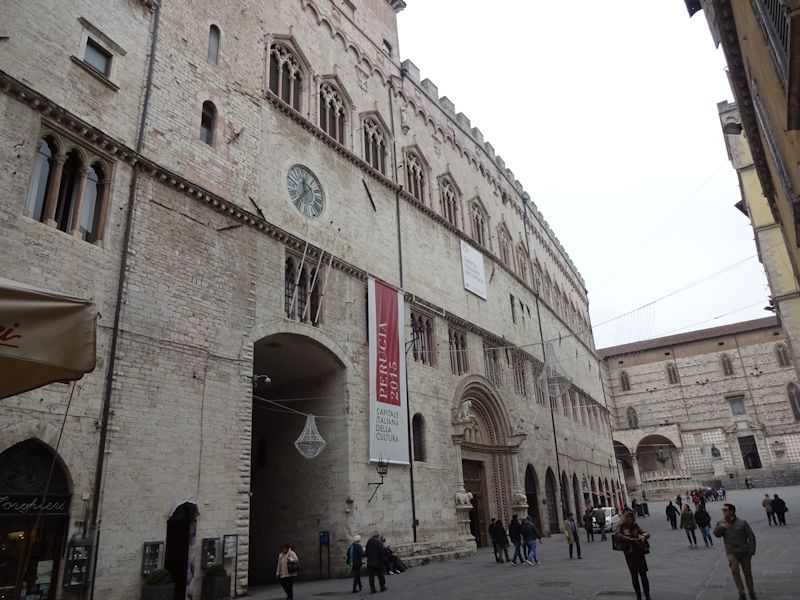
In the huge Palazzo dei Priori, this is the Galleria Nazionale dell'Umbria, an excellent art gallery (recently called "the best museum in Italy", by one measure).

Juvenile sociodynamics in the Via Cesare Fani

The Piazza Giacomo Matteotti, parallel to the high street. The Late Middle Ages were trying times for the locals, with nearly constant wars against other cities in the region (and as far away as Siena, which the Perugini captured in 1358) and various occasions when mercenary commanders claimed lordship over the city, and usually died within a few years. Like Biordo Michelotti, a native son then in service as Captain General of Florence, who in 1392 took advantage of local street battles between the "Rough" party and the nobles to step in and make himself Signore of the city. He was assassinated five years later, and Gian Galeazzo Visconti, the Duke of Milan, took the city under his wing and allowed Biordo's brother Ceccolino to take over again, but the notorious condottiere Braccio da Montone, who'd been exiled from Perugia as a youth, after years of fighting for whomever paid, came back with his company of bracceschi in 1416 and administered Perugia himself. Despite his continued career fighting first for Joanna Queen of Naples and then against her for the Aragonese, he's said to have given Perugia a welcome period of peace and prosperty until his death in 1424.
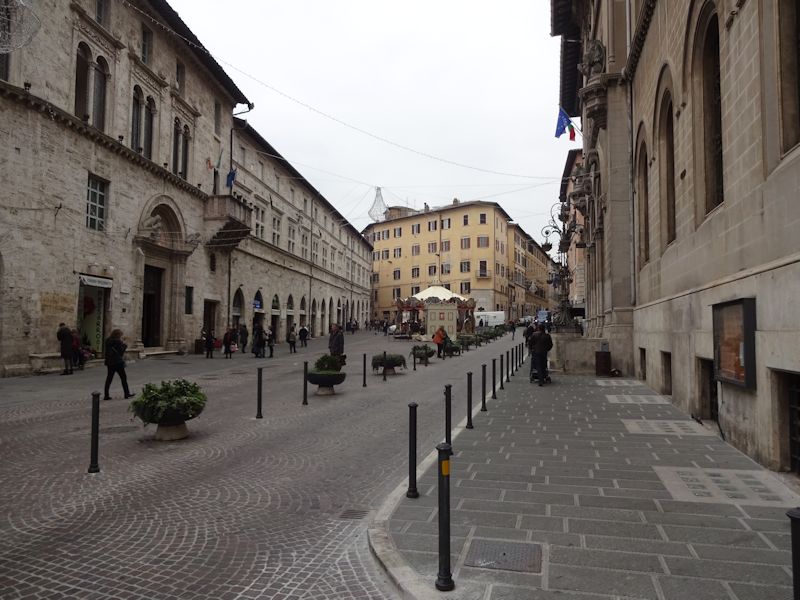
The new Palazzo del Capitano del Popolo is on the left. Feuds amongst noble families in town, as in many cities, disturbed the peace throughout the 15th century, until the brutal Baglioni family bested the Oddi clan for dominance in the late 1480s; they behaved atrociously in all ways, until in the late 1530s one of them tried to assassinate the papal legate and Pope Paul III moved in, destroyed all of the Baglioni palaces, and in 1538 built the Rocca Paolina fortress over them. Perugia's history is the Papal States' history thenceforward, until Napoleon set the city up as the capital of his Tiberina Republic in 1797 and, in 1859, the papal troops massacred lots of the citizens, and Perugia joined the unified kingdom of Italy.

Back up to the Palazzo dei Priori

The Corso Vannucci just near the Piazza IV Novembre
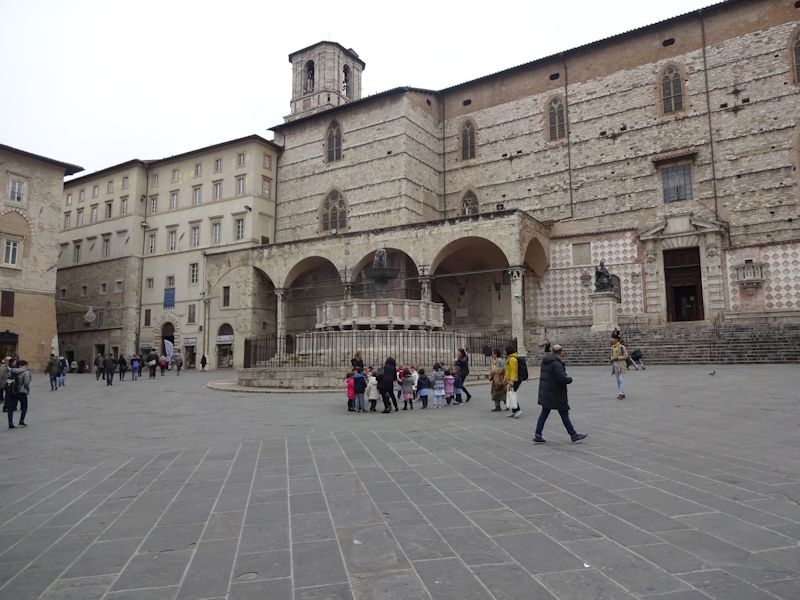
The central Piazza IV Novembre, evidently so named to celebrate the referendum on that date in 1860 when the people of Umbria voted to join the new Kingdom of Italy. To the left behind the Fontana Maggiore, under the cathedral belltower, is the former Palazzo delle Canoniche, built in the 15th century after the canons of San Lorenzo were forced to sell off much of their old buildings to be joined to the Palazzo del Podestà across the alley to the left. In the centre is the Loggia di Braccio, and to the right is the side door of the Duomo.
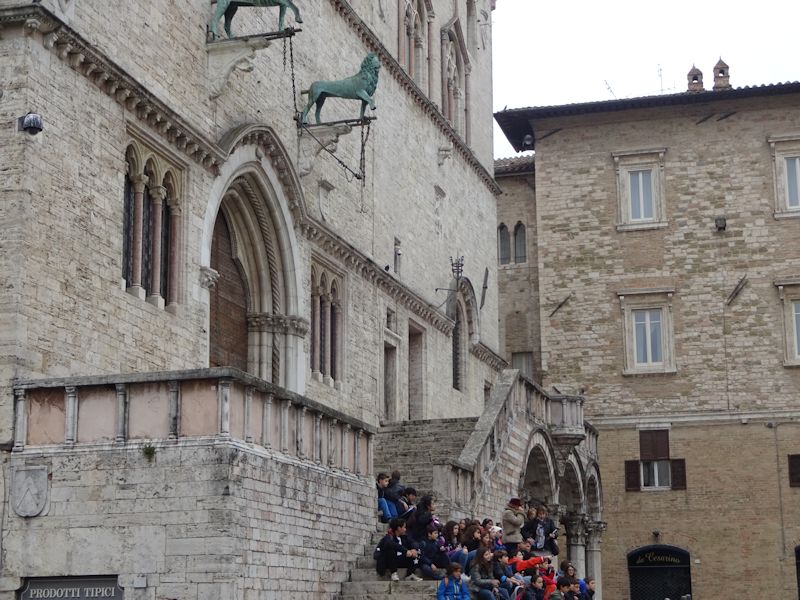
The steps of the Palazzo dei Priori facing the Piazza
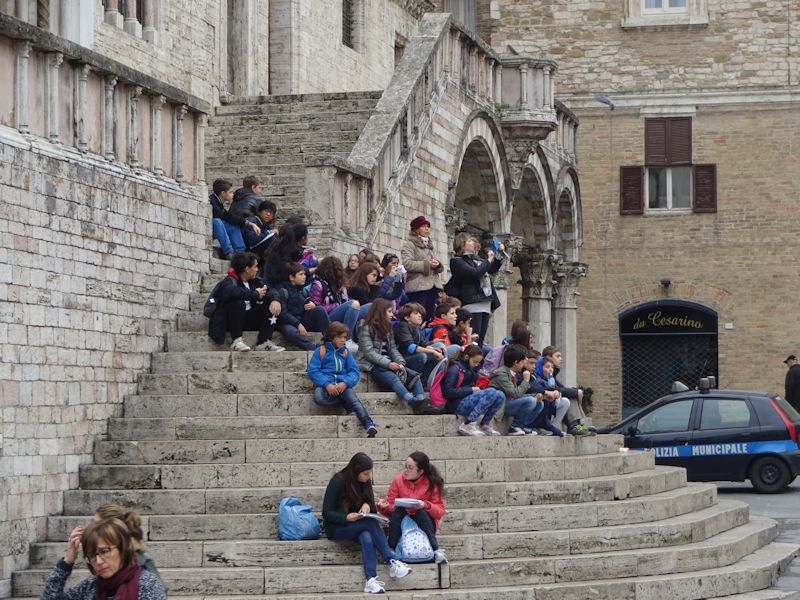
School trip to the city

Distracting the little ones till the schoolbus arrives

This is the famous Fontana Maggiore, built in 1277-78 amongst a number of ambitious civic improvements to celebrate the independence of the free commune at that time. The sculptures are by Nicola and Giovanni Pisano, and the hydrological works were provided by Fra Boninsigna, the same fellow who designed the aqueduct that brought water from the hills in the north to this central square, then called the Piazza Grande.
The Palazzo Vescovile, or Episcopal Palace (on the left), was built in the 1560s to comply with Council of Trent decrees about bishops having to reside on-site. It was built over the remains of the Palazzo del Podestà (the three different windows on the first floor are leftovers from that), which had been built in about 1205 for the offices and residence of the podestà (the chief magistrate of the city hired on short-term contracts from outside), but which had been burnt down in 1534, leaving the Loggia di Braccio stranded on the side of the Duomo.

The side door of the Cathedral of San Lorenzo, created in 1568. The exterior decoration was never completed, but the intended design can be seen on the first level above the stairs. The statue honors Pope Julius III, who restored the city's privileges in 1555 after Pope Paul III had abrogated them at the conclusion of the 'Salt War' in 1540. The arms to the left of the door are those of Ladislaus the Magnanimous, King of Naples, who was overlord of Perugia from 1408 to 1414, having held off a Florentine army led by Braccio da Montone and other condottieri amongst his other short-lived conquests. The external pulpit to the right of the door was built for the popular 'Bonfire of the Vanities' preacher San Bernardino of Siena, who whipped up the crowd from here in 1425 and 1427.
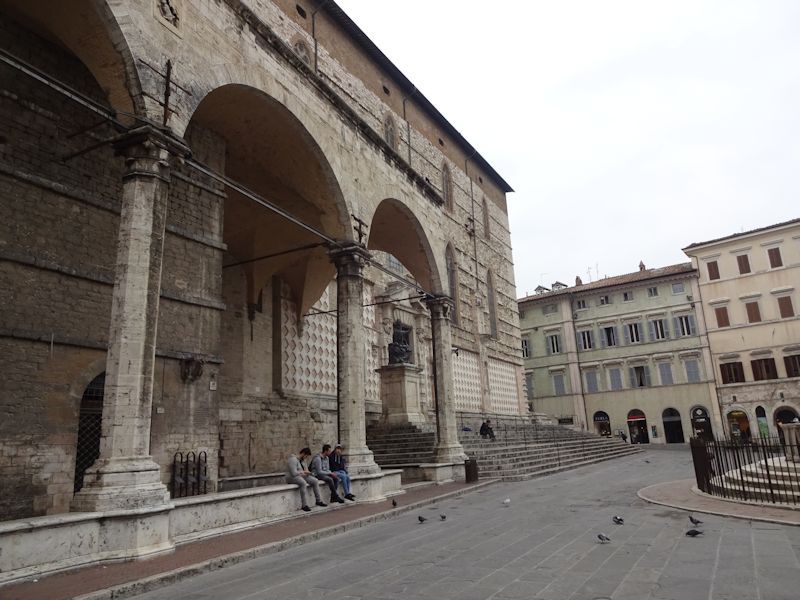
The Loggia of Braccio and the side of the Duomo. The mercenary commander Braccio Fortebracci, called Braccio da Montone, lived in the Palazzo del Podestà during his lordship of 1416-1424 and added the loggia in 1423 to connect his residence to the cathedral. The Palazzo was later used by papal authorities but was burnt down by the Baglioni, leaving the loggia stranded, when they assassinated the papal representative in 1534.
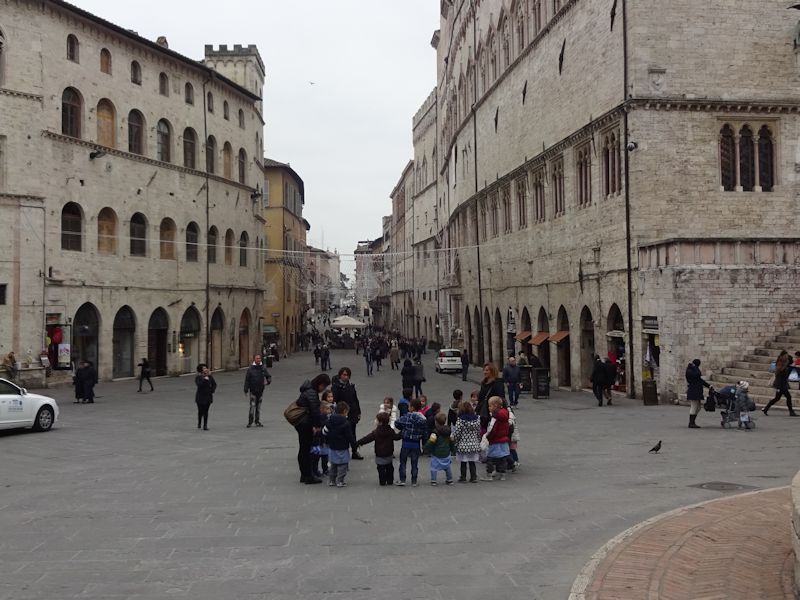
Just time for another song and dance before . . .
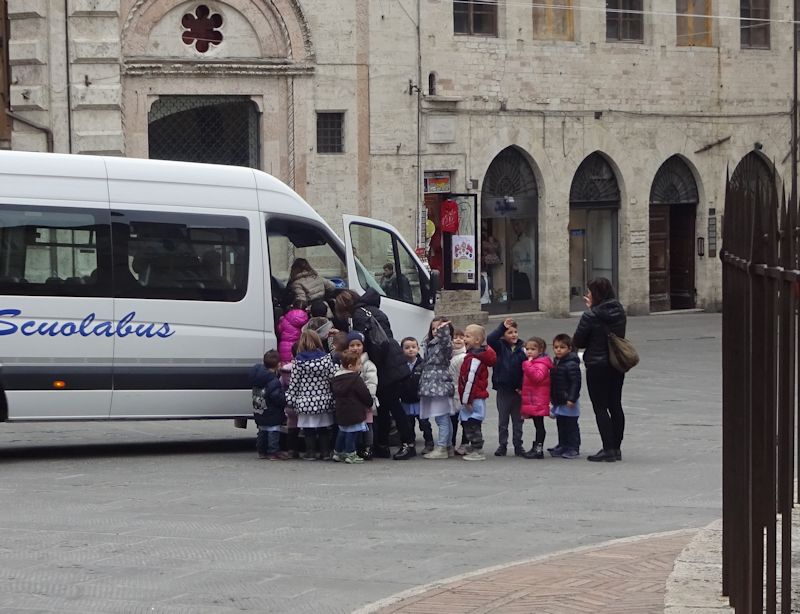
. . . the schoolbus arrives.

The oldest part of the Palazzo dei Priori is the Sala dei Notari (also 'dei Notai', same meaning) at the top of the stairs, begun in 1293-97, with the bronze Perugian griffin and Guelph lion over the door; it was used for city business by the city leaders from the best families (the priori) and others who had traditional seating in the town council, like the guild of the moneychangers and another of the merchants, who acquired their own additions to the palazzo as it was extended farther along the corso during the 14th century. The lawyers' guild, the Notari, were given the use of the main room in 1582 when their old place got demolished in an urban renewal (we'll see inside a little later).
The defensive crenellations along the roofline were destroyed in 1610 to demonstrate sufficient submission to the papal bosses, but restored when Perugia voted to sign up to the new, non-papal Kingdom of Italy in 1860. The three-arched portico may be a remnant of a pre-existing church of San Severo; now it's the municipal police post.

The Fontana Maggiore again, fed by an aqueduct down from the mountains to the north, two polygonal basins with some interesting sculptures of the lion and griffin, the labors of different seasons of the year, Old Testament scenes, and of course saints, by the Pisano father and son.

Street scene in the Piazza Danti
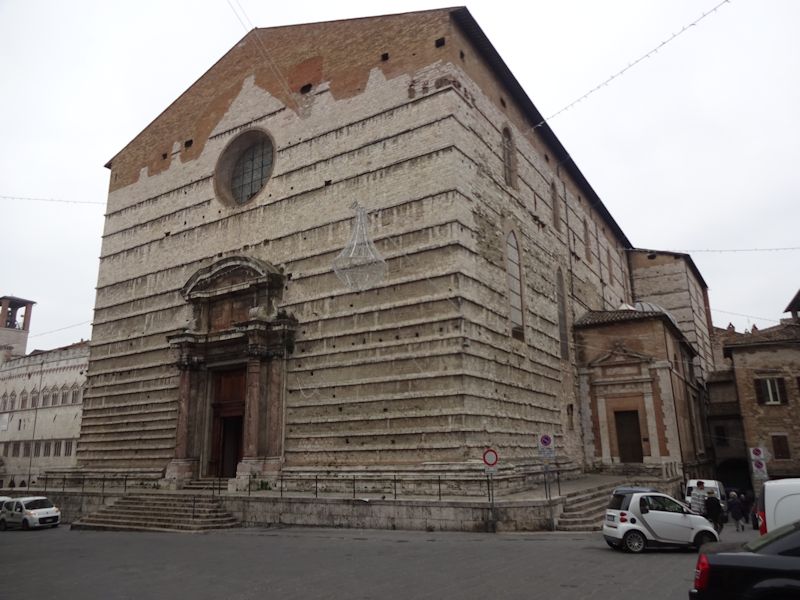
The façade of the Cattedrale di San Lorenzo, in the Piazza Danti. Work on the Duomo was begun in 1345 but suspended following the devastation of the Black Death a few years later; it continued over the years but was seriously got under way again in the 1430s, and the interior was completed by about 1490. The exterior has never really been completed.

The impressive front door dates from 1729.
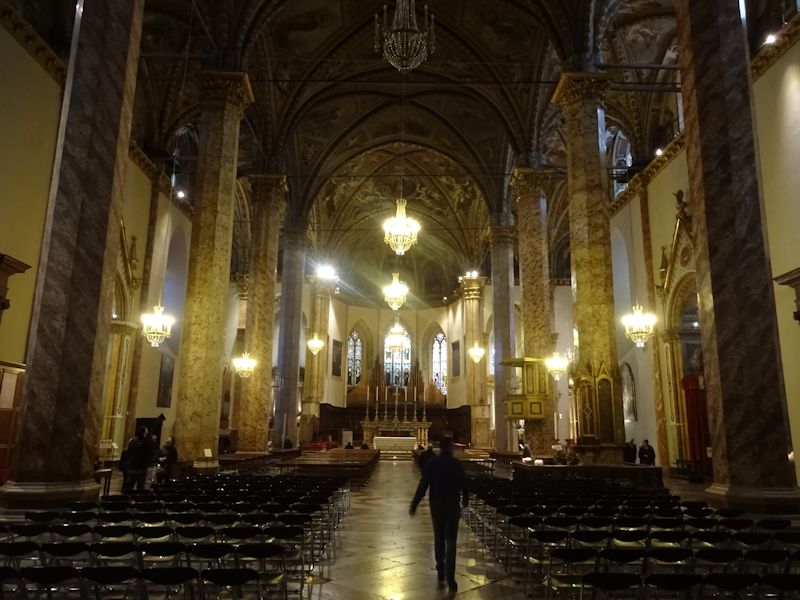
An attractive nave with two aisles

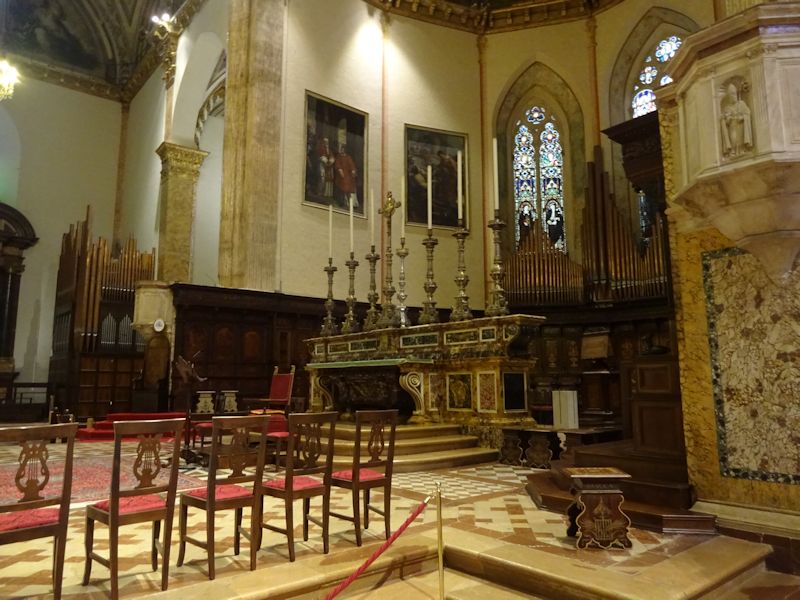
In the apse is an intarsia wood choir from 1486-91, but it was damaged by fire in 1985; we can't get any closer than this to see the present state of things.

Just to the right of the front door, behind the pillar, is the small chapel of the Holy Ring, containing the wedding ring of the Virgin Mary, which the Perugini stole from the city of Chiusi in 1473.

The Julius III statue and Loggia di Braccio

Kristin's looking for us; it's time for the National Gallery of Umbria.

Farther along the massive Palazzo dei Priori, this is the excellent Galleria Nazionale dell'Umbria. The collections had their origins in the painting academy of the 16th century, but they benefit most from the suppressions of religious institutions in the region under Napoleon's administration 1797-1799 and under the Kingdom of Italy after 1860, when much church property was turned over to the state.
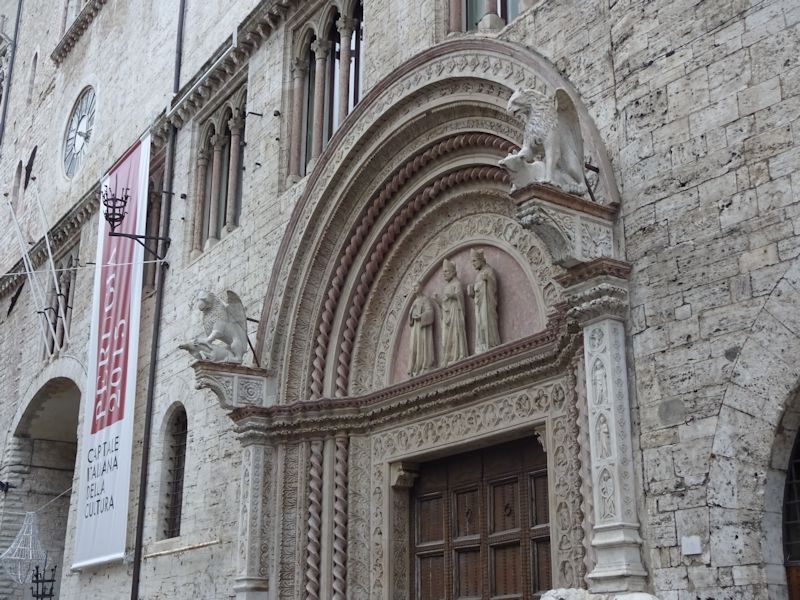
The wonderful front door, with griffins mauling lambs
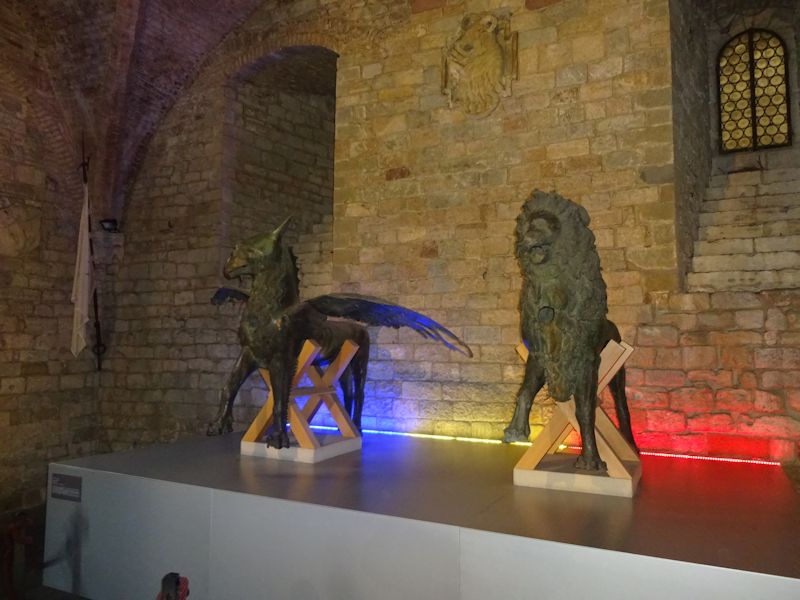
The griffin of Perugia and lion of the Guelphs

The lobby of the National Gallery, in front of the ticket office; the collections are on the third floor, served by a tiny elevator and a big staircase of equestrian proportions.
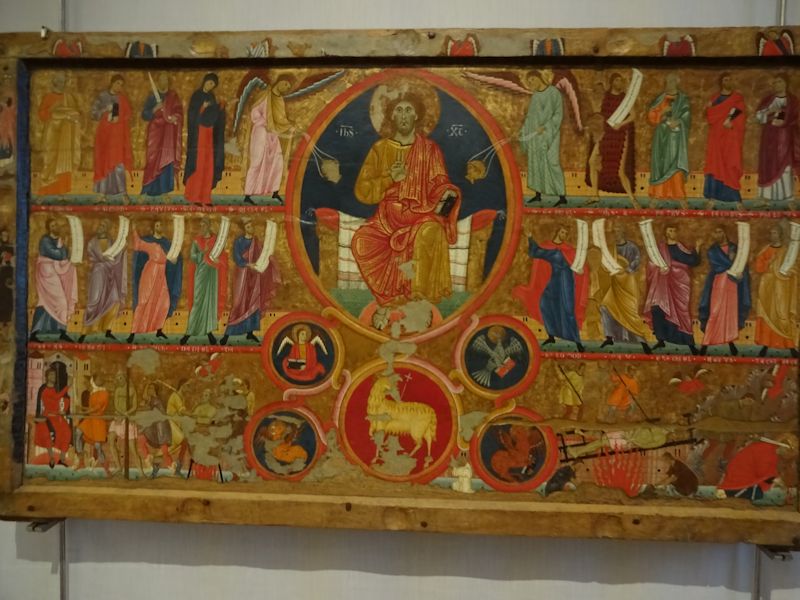
The gallery is probably strongest in works in various media from the Mid- and Late Middle Ages, especially Sienese from the early period and Perugian from the later; this is a reredos or retable by the Maestro di San Felice di Giano, about 1250.
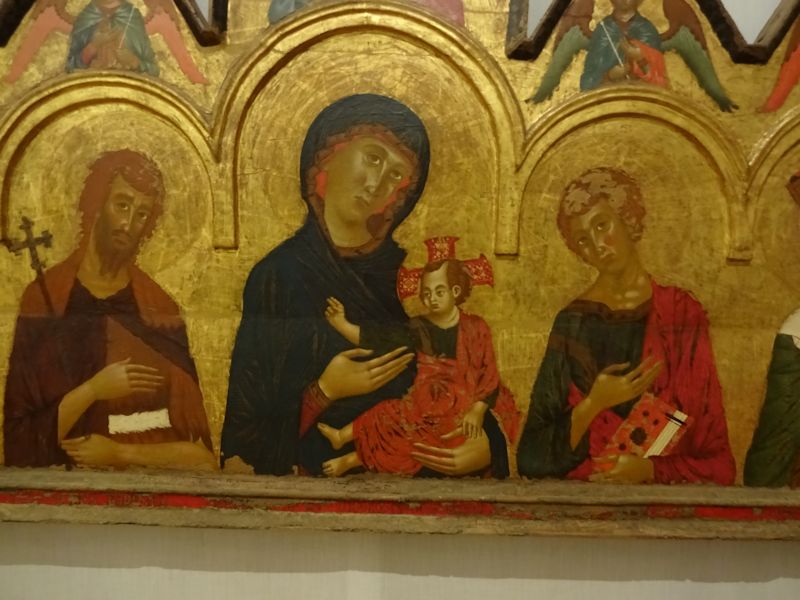
Another funny Jesus, this by Vigoroso da Siena, ca. 1291

Saint Agatha looks merely puzzled about why she's holding her iconographic breasts on a plate. The fellow on the left is St Liberator (or Eleutherius), the young Bishop of Messina (or Illyricum), who with his mother was clubbed to death on the orders of Emperor Hadrian. (Altarpiece of Sant'Agata, by Lello da Velletri, ca. 1427)

A happy Baby Jesus; Gentile da Fabriano, Madonna in trono col Bambino e angeli (1405-1410)
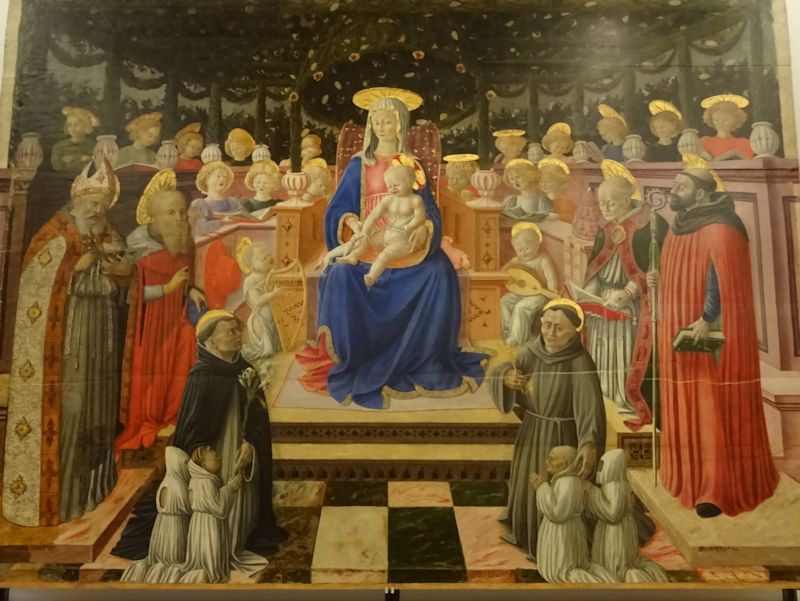
'The Madonna and Child Enthroned with Lots of Saints and Angels and Four Very Tiny Donors' (Madonna del Pergolato, by Giovanni Boccati, Perugia, 1446-47)
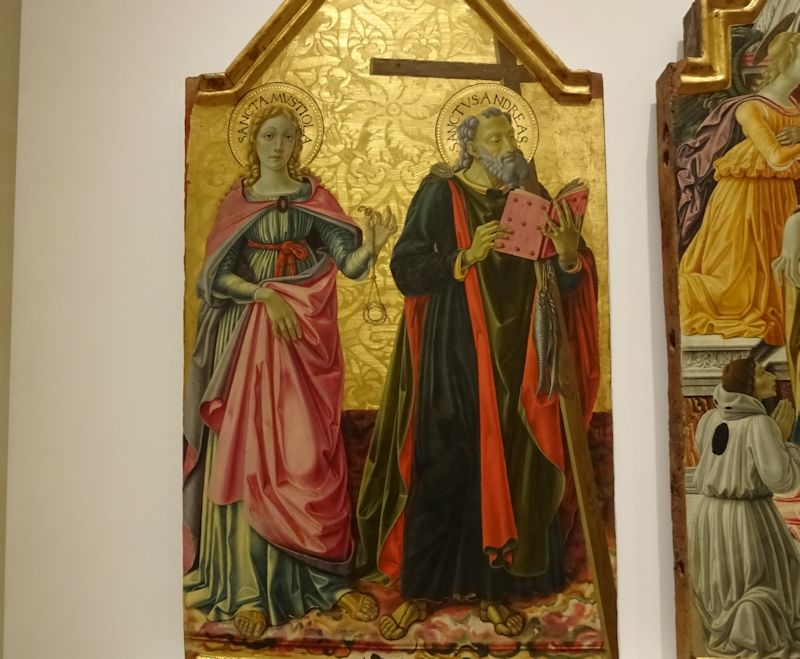
The Santa Anello. Saint Mustiola was a noblewoman in nearby Chiusi (supposedly a cousin of the Emperor Claudius II Gothicus) who with St Irenaeus was clubbed to death by Roman authorities in AD 273 for succoring Christian prisoners (or for resisting the advances of a local bigshot). Somehow (not well explained) Mustiola brought to Chiusi the Santa Anello or Holy Ring, an unwieldy quartz ring from the Virgin Mary's wedding to St Joseph (identified as such by its miracles); it was long kept in the custody of the canons of Santa Mustiola and was thus associated with that saint, and it proved to be a significant revenue source for the city (sometimes its only one).
In 1473, however, a German friar named Vinterio stole the Ring and retired to comfort in Perugia, despite having been found guilty of the theft in Perugia's courts. After 1488 the Ring was displayed in a chapel of the Duomo of Perugia; a few years later, Pope Sixtus IV ruled in favor of Perugia and compensated Chiusi by formally recognizing the cult of St Mustiola for pilgrimage purposes. (A panel from the Triptych of Justice, 1475-76, by Bartolomeo Caporali and Sante di Apollonio del Celandro, made just two years after the theft of the Ring)
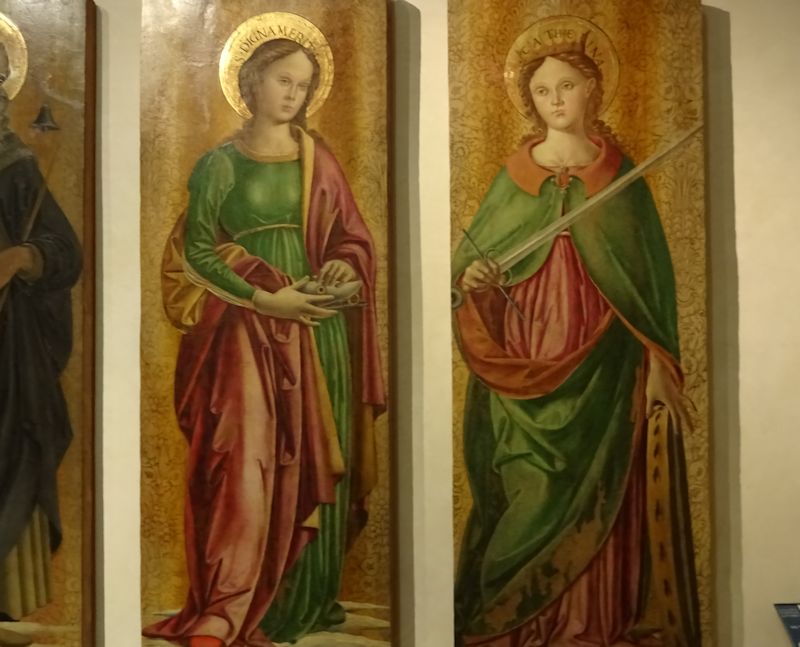
Saint Dignamerita (green dress, red cloak) and Saint Catherine of Alexandria (red dress, green cloak, and a wheel with spikes on it), virtually twins, both blasé. St Dignamerita may have been Saint Digna and Saint Emerita and is for some reason holding a fish with a ring in its mouth. (part of an altarpiece, ca. 1498, by Fiorenzo di Lorenzo)
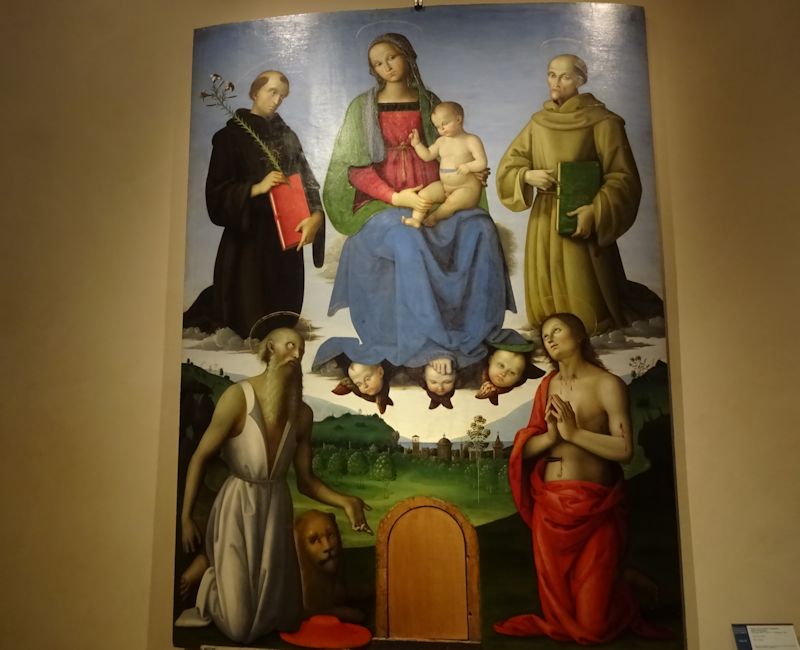
Madonna Standing on Children's Heads, with Saints (by Il Perugino, 1500)
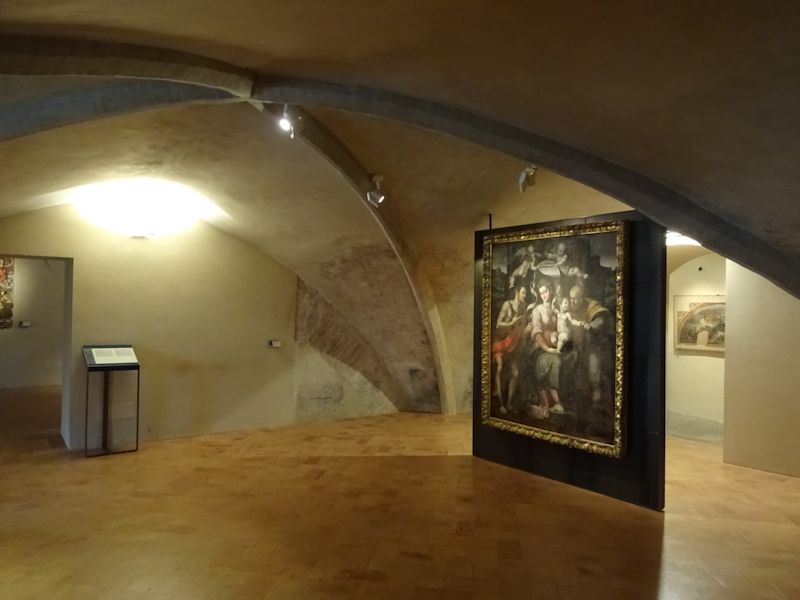
In the beautiful National Gallery of Umbria

The courtyard
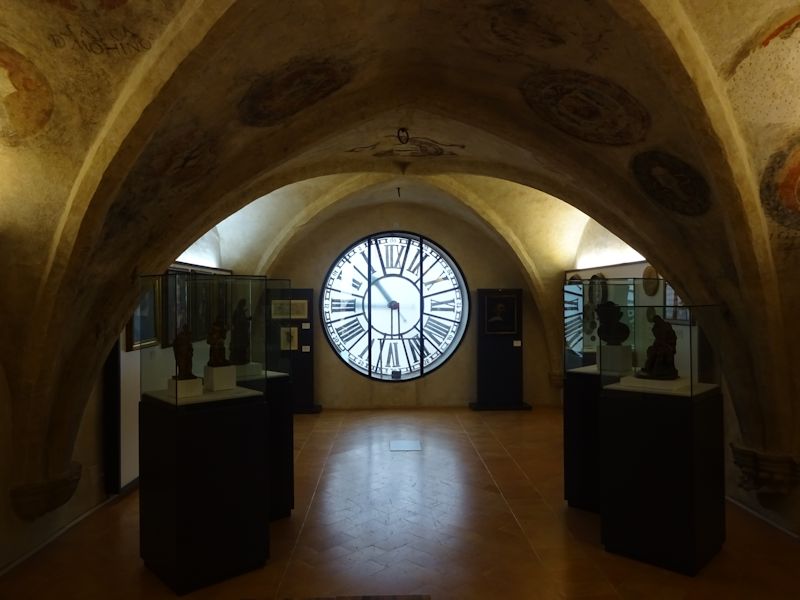
The clock overlooking the Corso Vannucci (from the inside)
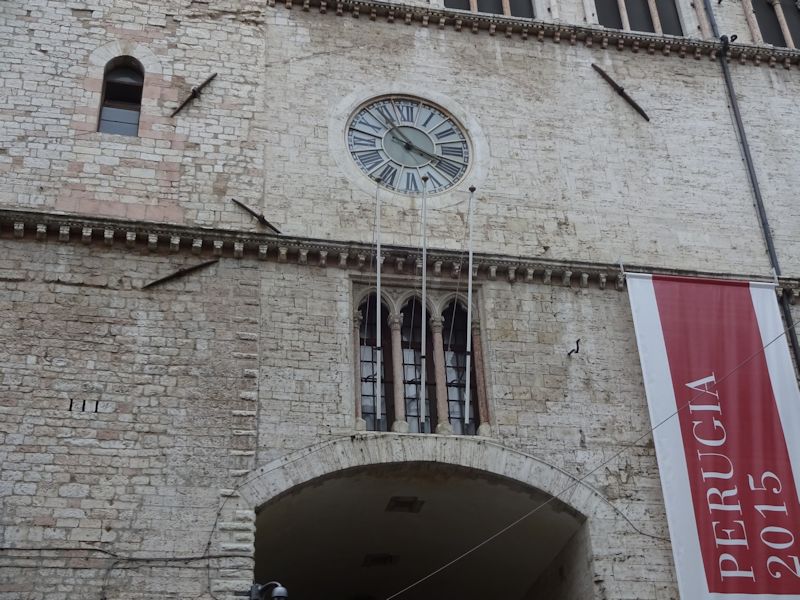
The clock overlooking the Corso Vannucci (from the outside)
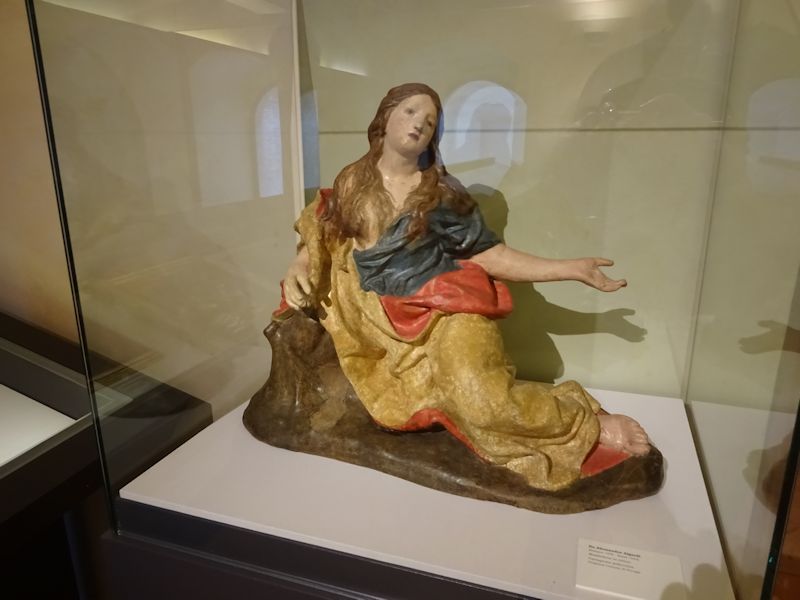
We collect Mary Magdalenes (Maddalena in estasi, by Da Alessandro Algardi, mid-17th century, a rival of Bernini though this gives no suggestion of why)
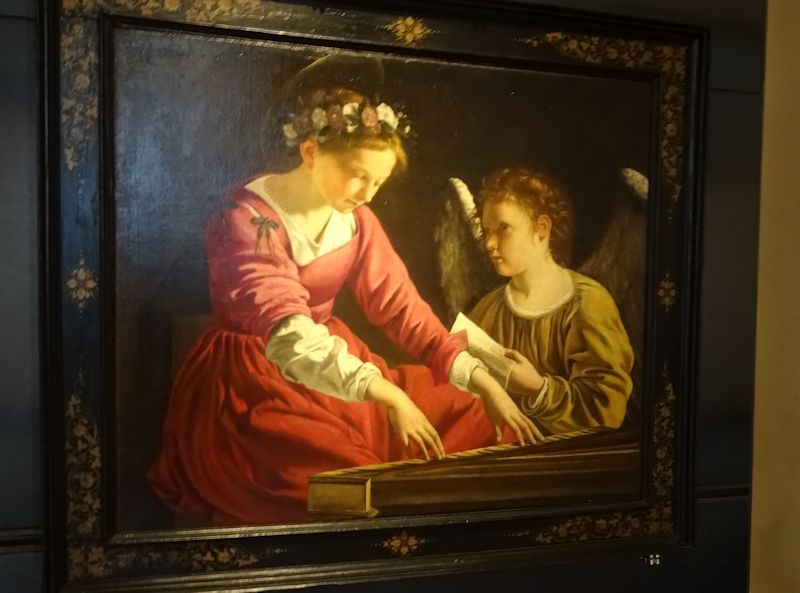
Saint Cecilia playing the spinet, assisted by an angel (by Orazio Gentileschi, ca. 1620) -- Cecilia is the patron saint of musicians, especially church musicians, and Omaha.

Exhausting. It's time, with a fine view of the Fontana Maggiore, for an 'OT DAAG' (hot dog), mit senf, in an Iranian shawarma shop. And then on to the amazing Pozzo Etrusco.














 Dwight Peck's personal website
Dwight Peck's personal website






















































